Why Floor Lifts Are Essential for Safe Patient Handling
A floor lift is a mechanical device designed to safely transfer individuals with limited mobility from one position to another, such as from the floor to a wheelchair or between different surfaces. These mobility aids use hydraulic or electric systems with slings to provide dignified, injury-free transfers for both patients and caregivers.
Key Floor Lift Types:
- Manual Hydraulic - Hand-pumped operation, 300-600 lb capacity
- Electric Powered - Battery or plug-in operation, easier for caregivers
- Sit-to-Stand - Assists partially mobile individuals
- Mortuary/Bariatric - Heavy-duty models up to 1,000+ lbs
- Stair Chairs - Battery-powered for multi-level transport
Whether you're a funeral home director handling bariatric cases, a healthcare facility reducing caregiver injuries, or a family caring for an elderly loved one, floor lifts have become essential equipment. Research shows these devices significantly reduce musculoskeletal injuries among healthcare workers while maintaining patient dignity during transfers.
I'm Mortuary Cooler, a national-level mortuary cooler supplier with extensive experience helping funeral homes select the right floor lift equipment for their specific needs. My background includes working with heavy-duty mortuary lifts and understanding the unique space and capacity requirements that funeral directors face daily.
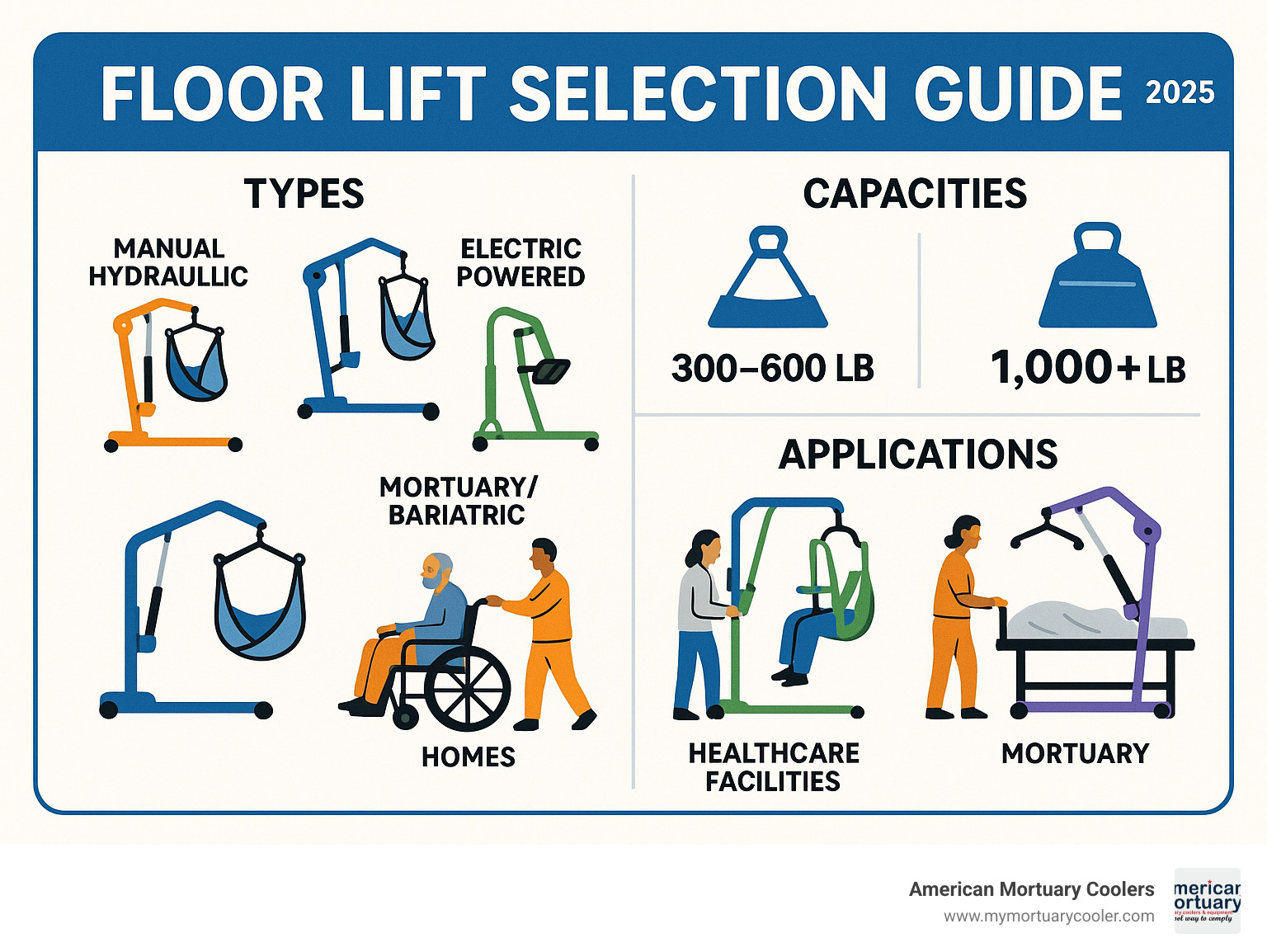
Easy floor lift glossary:
How a Floor Lift Works & Who Benefits
A floor lift works as your reliable mechanical assistant through either hydraulic pressure or electric motors to smoothly raise and lower people who need help moving around. A specially designed sling wraps comfortably around the person, connecting to a spreader bar that evenly distributes their weight.
Who benefits from floor lifts? Patients with limited mobility find new dignity in transfers that don't require multiple people lifting. Elderly individuals can move safely without fear of falling. People with disabilities gain greater independence, while caregivers experience the biggest change.
Healthcare workers have found that floor lifts transform their daily work experience. No more dreading patient transfers or going home with an aching back. These devices excel in fall recovery, rehabilitation, and routine patient handling, dramatically reducing musculoskeletal injuries.
Anatomy of a Floor Lift
Every floor lift shares essential components: the wheeled base provides stability and mobility, with locking casters serving as your safety anchor. The hydraulic pump or electric motor provides lifting power, while the spreader bar distributes forces evenly across the patient's body.
Modern floor lifts feature user-friendly control handsets with emergency stop buttons and emergency lowering systems that work even during power outages. Electric models include rechargeable battery packs providing 30-50 lifting cycles per charge.
Why Caregivers Prefer a Floor Lift
Traditional manual lifting puts enormous stress on caregivers' spines, leading to injury rates that prompted OSHA safety guidelines. The shift toward single-handed care has made floor lifts essential as facilities operate with leaner staffing.
Scientific research on caregiver injuries shows mechanical lifting devices reduce workplace injuries by up to 60%. This translates to lower workers' compensation costs, reduced staff turnover, and improved job satisfaction among caregivers.
Main Types of Floor Lift Solutions
When shopping for a floor lift, the variety means you can find exactly what you need. Manual hydraulic models are reliable workhorses that function during power outages. Powered electric versions eliminate physical effort, making them favorites for frequent use.
Sit-to-stand lifts assist partially mobile individuals, while overhead ceiling systems save floor space. Portable models offer flexibility, and specialists include stair chairs, mortuary lifts, bariatric models, and pediatric versions.
Manual vs. Electric Floor Lift
The choice often depends on usage frequency and operators. Manual models use hand-pump systems, typically handling 300-600 pounds with lower upfront costs. Electric models use button operation, charging in 2-4 hours for 8-12 hours of operation, often handling 700+ pounds.
Quick comparison:
| Feature | Manual Hydraulic | Electric Powered |
|---|---|---|
| Weight Capacity | 300-600 lbs | 400-700+ lbs |
| Power Source | Hand pump | Battery/AC |
| Operation Effort | Moderate physical | Minimal |
| Initial Cost | $700-1,500 | $1,200-3,000 |
| Emergency Use | Always available | Battery dependent |
Specialty Floor Lift Designs for Unique Settings
Stair evacuation chairs like the MOBI EZ handle up to 500 pounds and "can operate for the equivalent of 30 trips up and down a 5-story building on a single charge." Outdoor waterproof models like the Platinum Health Phoenix feature 100% waterproof systems lifting up to 300 pounds.
Vehicle transfer systems help with car access, while home elevators provide permanent multi-story solutions. For funeral professionals, More info about Low-Profile mortuary lifts covers specialized equipment.
When a Mortuary Floor Lift Is the Right Choice
Funeral homes need specialized mortuary lifts with 1,000+ pound capacities for bariatric cases and heavy caskets. These units combine incredible strength with quiet, respectful operation appropriate for funeral environments.
These specialized units feature marine-grade aluminum construction for decades of reliable service while maintaining dignified appearance. The investment pays for itself through improved staff safety and operational efficiency.
For comprehensive guidance, The Ultimate Guide to Mortuary Lift Products – American Mortuary Coolers provides detailed equipment selection information.
Key Buying Considerations & Safety Features
When shopping for a floor lift, focus on key factors to find the perfect match. Weight capacity tops your priority list - consider current and future needs. User height range matters equally, as lifts must accommodate different body sizes.
Sling compatibility deserves attention since manufacturers often use proprietary systems. Ensure replacement slings will be available and reasonably priced. Physical space dimensions dictate many features - base width adjustment ensures navigation through doorways while maintaining stability.
Dual-speed lift controls provide precise positioning, while low ground clearance works with standard beds and wheelchairs. Consider waterproof rating for healthcare environments, warranties, financing options, insurance reimbursement, and ADA guidelines compliance.
Matching Floor Lift Capacity to Patient Needs
Standard 300-lb capacity models handle most elderly individuals and routine transfers, offering affordability and functionality for typical home care. Bariatric applications demand 500-lb range for larger individuals with reinforced construction.
1,000-lb mortuary capacity units handle the most challenging cases for funeral homes and specialized applications. Clearance measurements prove equally important - measure twice, buy once to ensure your floor lift fits under beds, through doorways, and around furniture.
Essential Safety Features
Emergency lowering systems provide controlled descent during power failures or mechanical problems. Anti-sway mechanisms eliminate unwanted movement, while locking casters secure the base during operation.
Audible battery alarms warn before power runs low, preventing mid-transfer stops. Overload sensors prevent operation beyond safe weight limits, protecting users and equipment. Modern floor lifts incorporate multiple redundant safety systems.
Home-Use vs. Facility-Grade Floor Lift
Home models prioritize compact footprint and décor integration since they often become permanent fixtures. Facility-grade units are built for high-duty cycles with infection-control upholstery designed for hospital-grade disinfectants.
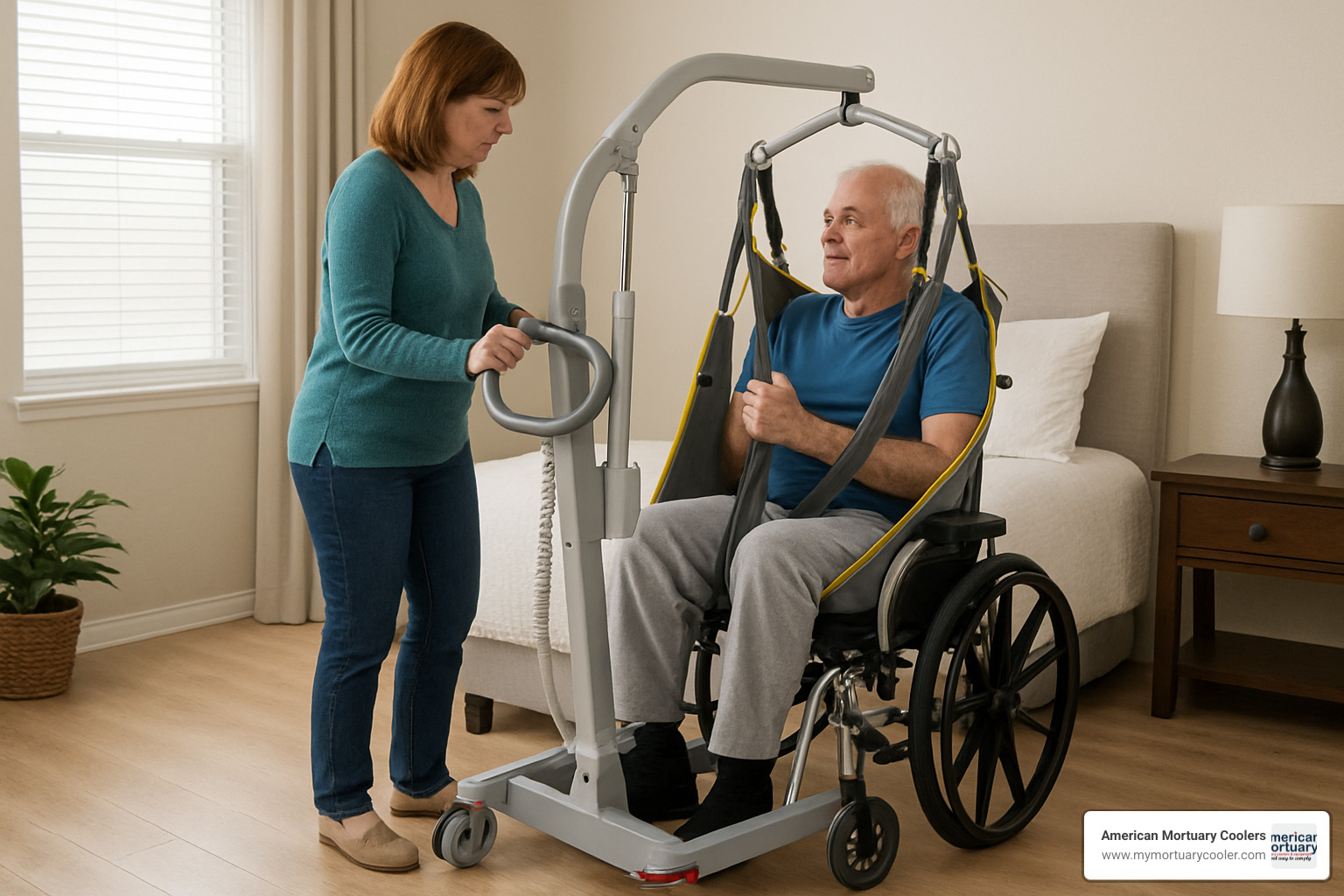
Facility models use heavier gauge materials, robust electrical systems, and components rated for thousands versus hundreds of cycles. Your choice depends on usage frequency, aesthetic concerns, and budget considerations.
Operating, Training & Maintenance Best Practices
Getting the most from your floor lift starts with proper operation training. Smart caregivers develop pre-lift checklists: check slings for tears, verify battery charge, test emergency stops, and ensure base legs spread properly.
Caregiver ergonomics still matter. Position yourself close to controls, keep your back straight, and move smoothly. Annual professional servicing keeps units running safely, while proper battery maintenance prevents power failure during transfers.
Step-by-Step Safe Operation of a Floor Lift
Safe floor lift operation follows a logical sequence. Position the lift properly with the base straddling the patient. Sling attachment requires careful attention - the sling must distribute weight evenly with proper leg support and chest strap positioning.
Check spreader bar connections twice before lifting. During lifting, maintain constant communication and watch for discomfort signs. Move deliberately during transfers, then lower slowly ensuring the receiving surface properly supports the person.
Caregiver Training & Certification Resources
Manufacturer-provided training gives the best foundation. In-service demonstrations work well for floor lift training through hands-on practice. Many manufacturers offer e-learning modules for busy caregivers' schedules.
Recognized training organizations include the Association of Safe Patient Handling Professionals (ASPHP), American Organization for Nursing Leadership (AONL), and the National Institute for Occupational Safety and Health (NIOSH).
Routine Maintenance & Troubleshooting
Regular maintenance prevents expensive breakdowns. Lubrication points include wheel bearings, spreader bar pivots, and hydraulic guides. Battery testing should happen monthly, not just when performance declines.
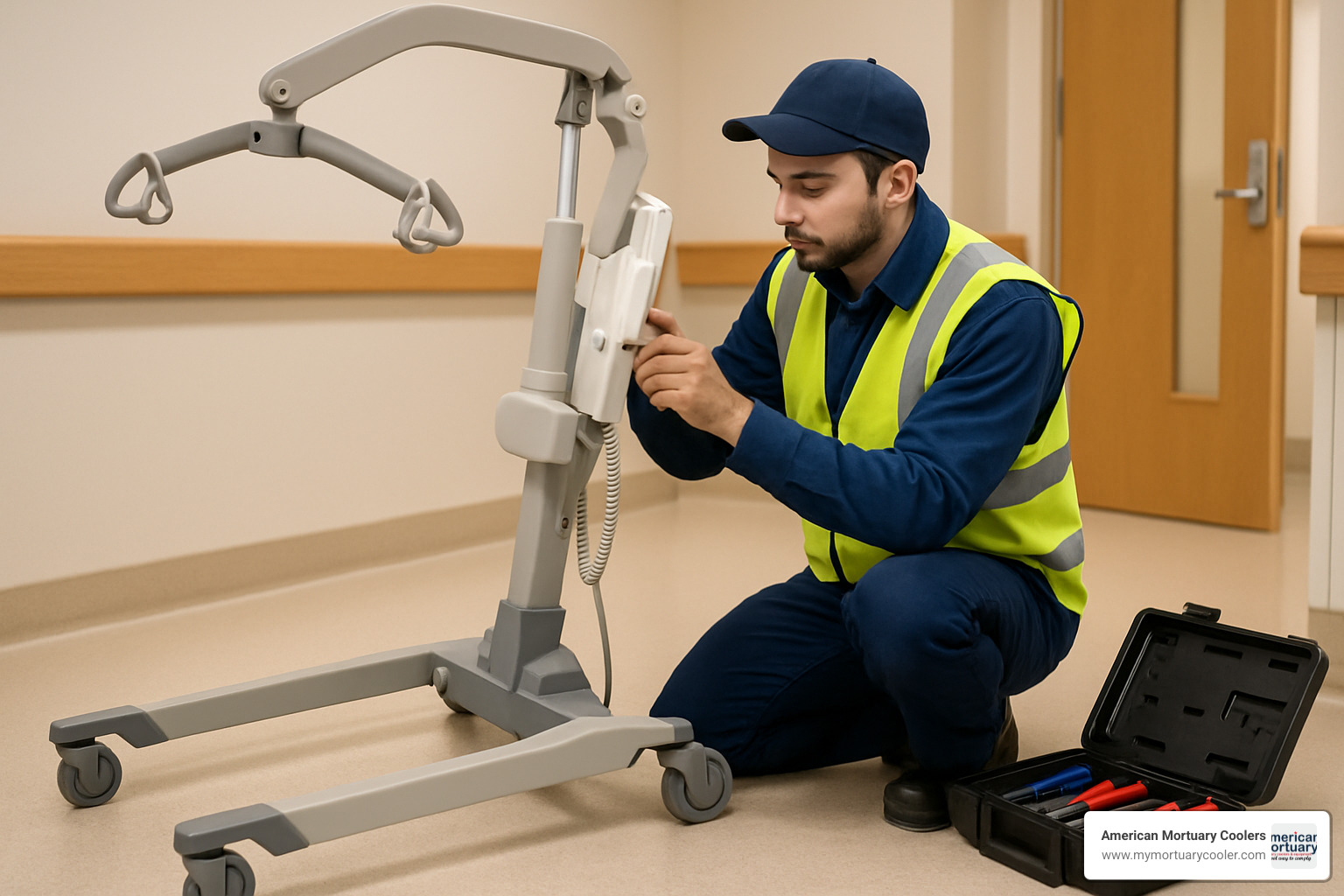
Replacement parts availability affects long-term costs. Service logs help identify patterns and prove invaluable for warranty claims. Common issues include battery problems, hydraulic leaks, and electronic malfunctions often resolved with simple resets.
Cost, Financing & Real-World Results
When shopping for a floor lift, prices range dramatically. Basic manual models start around $700, perfect for families beginning mobility assistance. Electric models typically run $1,200-$3,950, while heavy-duty mortuary lifts cost around $6,439.95.
Rental options work well for short-term needs or trying before buying. Medicare Part B covers floor lifts as durable medical equipment when prescribed. VA benefits help eligible veterans, and some mortuary lifts qualify for 50% tax credits.
Financing & Insurance Pathways
Medicare coverage requires physician prescription documenting medical necessity. Private insurance needs prior authorization with detailed justification. Equipment grants from foundations help when traditional funding falls short, while manufacturers offer payment plans spreading costs over 12-24 months.
Case Studies & Testimonials
Real families share amazing change stories. As one family member shared about the IndeeLift system: "This device has been a tremendous relief for our family!" One MOBI stair chair user bought six units after experiencing the first one's performance.
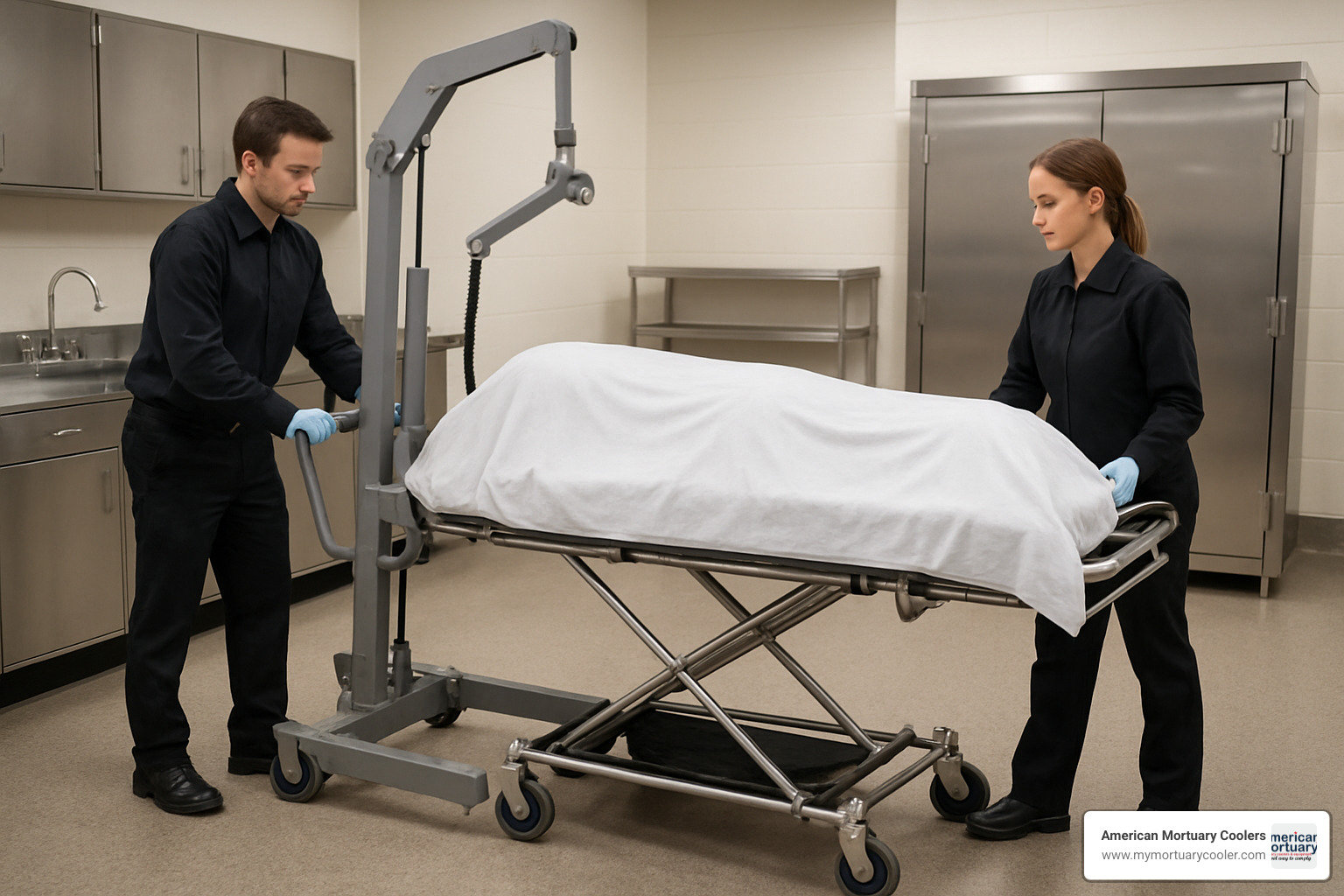
Funeral directors consistently report efficiency improvements with proper equipment. County coroners find that investing in quality floor lifts pays dividends in staff safety and operational efficiency.
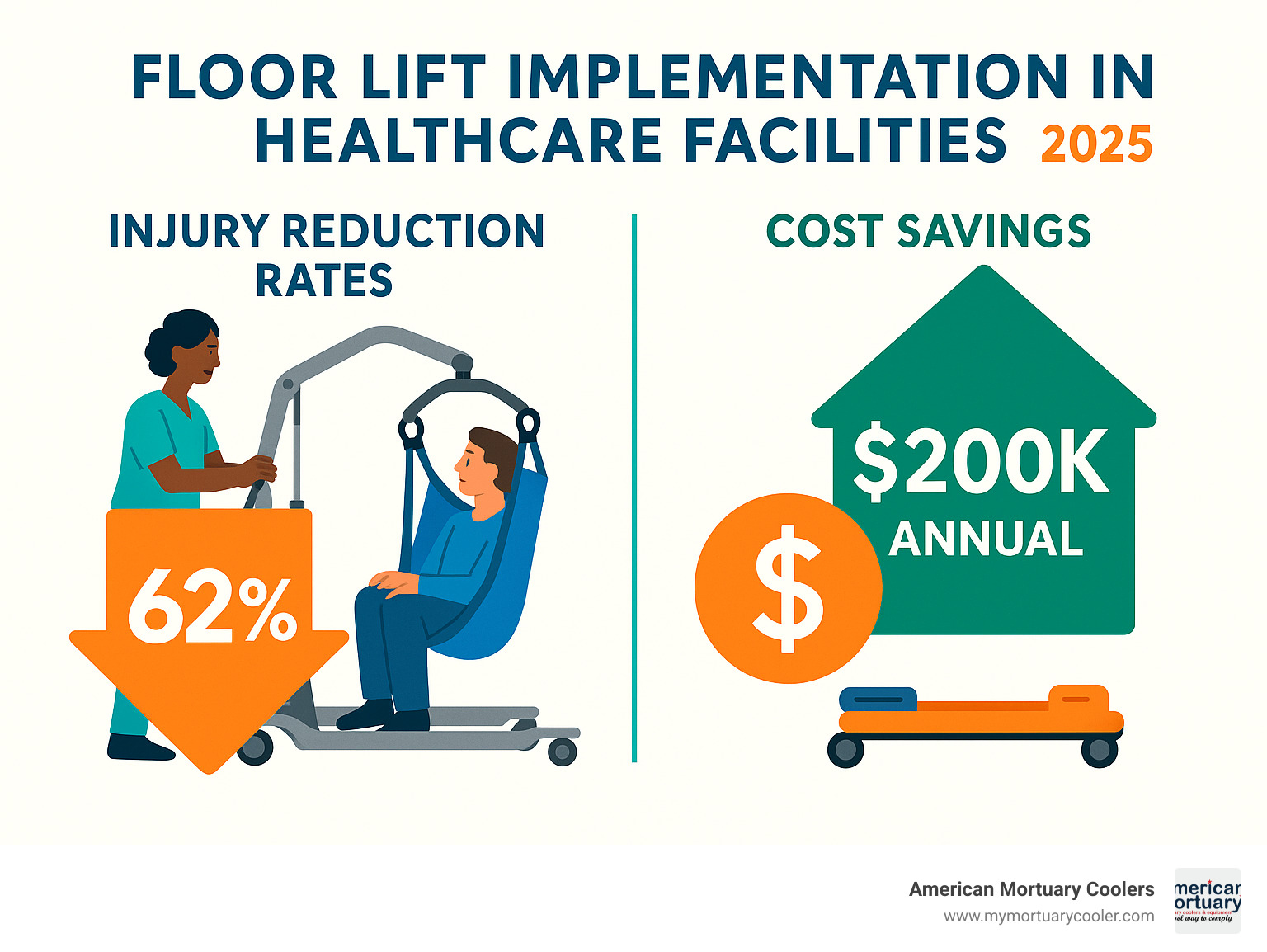
At American Mortuary Coolers, we've seen how the right equipment transforms funeral home operations. Quality floor lifts aren't just equipment purchases - they're investments in your staff's health and your facility's long-term success.
Frequently Asked Questions about Floor Lifts
How much space do I need for a floor lift in a home?
Most home-use floor lifts work comfortably in a 6-foot by 6-foot clear area. Standard units need at least 32 inches of doorway width and 8 feet of ceiling height for full extension. Consider storage space when not in use - some models fold for tucked-away storage.
Can one caregiver safely operate a powered floor lift?
Yes, powered floor lifts were designed for single-caregiver operation as healthcare facilities shifted toward single-handed care. Electric controls handle the heavy lifting with built-in safety features preventing unsafe operation. Proper training remains essential for safe, confident transfers.
What is the typical service life of a floor lift battery?
Most batteries provide 2-3 years of reliable service with regular use. The MOBI EZ provides "1.5 hours" of continuous operation or "30 trips up and down a 5-story building on a single charge." Lithium-ion batteries generally outlast lead-acid types while delivering more consistent power.
Conclusion
Selecting the right floor lift impacts safety and dignity for every person you serve. Whether caring for a loved one at home or managing funeral home operations, quality equipment makes the difference between struggling through transfers and handling them with confidence.
Floor lifts have evolved into sophisticated systems protecting both caregivers and patients. The investment pays for itself through reduced injuries, improved efficiency, and peace of mind from providing excellent care.
At American Mortuary Coolers, we've spent years helping funeral professionals steer equipment decisions. Our experience with heavy-duty mortuary equipment provides unique insight into durability and reliability requirements. We understand that when serving families during difficult moments, equipment cannot fail.
From our Tennessee headquarters, we deliver industry-grade solutions across the contiguous 48 states. Our regional presence in Johnson City TN, Atlanta GA, Chicago IL, Columbia SC, Dallas TX, Los Angeles, New York NY, and Pittsburgh PA means we're never far from communities we serve.
The funeral industry demands equipment performing flawlessly under pressure, and that durability translates perfectly to healthcare and home-care applications. When you choose equipment built to funeral industry standards, you're investing in reliability serving you for years.
For funeral professionals, More info about our mortuary lift solutions provides specialized guidance for your unique requirements.
The right floor lift is your partner in providing safe, dignified care. Whether preventing caregiver injuries, ensuring patient comfort, or maintaining respectful atmospheres families deserve, quality equipment makes it possible to do your best work every day.
















